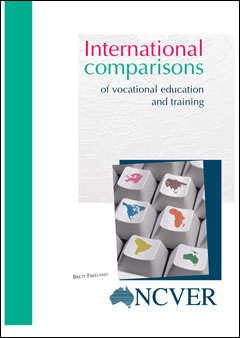Description
This report presents indicators available for international comparisons of vocational education and training. It examines a range of data collections, cultural variations and differences in policy objectives across countries. The study can assist educators, policy-makers, researchers and society in general to measure progress towards the realisation of national education and training goals, with the aim of improving education and training systems.
Summary
Executive summary
The report considers those indicators available for international comparisons of vocational education and training (VET). The principal data examined in the report are the Organisation for Economic Co-operation and Development's (OECD) annual Education at a glance: OECD indicators publications (OECD 1997, 1996). The range of issues addressed by this report includes:
- determining what kinds of comparability problems exist
- determining how widespread and severe comparability problems are
- determining the causes and nature of comparability problems
- a discussion of alternative methods to correct comparability problems
In recent years international comparative analysis has become a commonly used tool for policy-based decision-making. There has been a general acceptance of the findings of comparative studies and the field of VET has not escaped the influence of such studies.
International comparisons, as the name suggests, compare data derived from different countries. Comparative analyses attempt to achieve various objectives. Describing the existence of the same attribute in different locations is one such objective and describing the relative performance of countries based on measurable attributes is another. Determining whether the effort and funding put towards education and training is equal to that of national competitors is the major justification of these comparative analyses.
This report considers the current methodology utilised in the development and implementation of comparative analyses and finds them to be flawed due to several faults in the methodology and data collection.
Data used in comparative analyses are flawed for various reasons including the:
- validity (consistency across countries) of data
- accuracy of data
Several faults of international comparative statistics as they relate to education and training have also been identified. Faults can be introduced into data collection through the data collection processes at the national level, the compilation of the data at the international level and through the inappropriate use of the data during analytical processes.
No single version of best practice for comparative analysis of education and training has been found. However, the following questions may be used as guidelines and applied in the development and assessment of comparative analyses. If the questions can be answered in the affirmative, then the results derived from comparative analyses are more likely to be relevant and applicable.
- Are the data used comparable?
- Can the data be compared to data from other comparative analyses?
- Are the countries included in the comparison reasonably comparable in terms of their socio-economic profile?
Understanding the local context, its society and economic situation as well as gathering reliable data are essential to developing meaningful results from international comparisons. Comparative analyses currently tend to overlook the important need for accompanying contextual descriptions to support results presented.
If comparative analysis is to remain a useful research method, results must cross academic boundaries and describe, coherently and meaningfully, the national contexts from which data are attained. Descriptions and caveats accompanying findings from comparative analyses need to be as detailed and inclusive as possible, and detailed contextual information is essential. Such information provides users of the results with uniform and relevant perspectives of countries included in the comparison. Only with adequate and consistent data collection, theoretically sound methodology, and comprehensive contextual information, will the results of international comparative analyses remain relevant and useful to potential users.
Download
| TITLE | FORMAT | SIZE | |
|---|---|---|---|
| International-comparisons-403 | 700.0 KB | Download |
